The
Liffey
One
of the outstanding geographical features of the area is the river Liffey.
It meanders across Caragh, leaving a fine valley, abundant wildlife, many
architectural sites and an attraction to tourists.
THE
NAME.
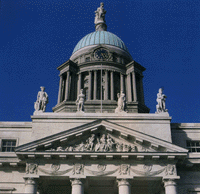 On
the walls of the Custom House, near the mouth of the Liffey, we can find the
riverine heads representing the main rivers of Ireland.
The only female head is the one representing the river Liffey.
On
the walls of the Custom House, near the mouth of the Liffey, we can find the
riverine heads representing the main rivers of Ireland.
The only female head is the one representing the river Liffey.
…
Once upon a time this river was known as RUIRTHEACH,
the flashy torrent. The story goes
that LIFE, the daughter of Cannan
the PICT and the wife of DELTBANNA
MAC DRAUGHT, of the palace of Tara, was travelling from Tipperary to Tara.
She was so impressed with the beauty of the plains of Kildare, through
which the river flowed, that she asked that the area be named after her. Her husband, DALTBANNA would
give out no more liquor to the men of Erin until the plain was named after LIFE.
The river would take the same name.
WILDLIFE…
 The
river and its banks have a very abundant wildlife.
Fish include salmon, trout, pike, perch and crayfish. Otter, wild mink
and stoat ply their trades along the banks.
The
river and its banks have a very abundant wildlife.
Fish include salmon, trout, pike, perch and crayfish. Otter, wild mink
and stoat ply their trades along the banks. 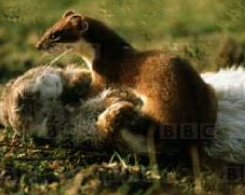 Plants include toothworth, wild garlic, Indian balsam, weasel snout. One
of the most recent residents is the mayfly. Cormorants nest along the river
while the beautiful kingfisher and the busy dipper are great sights to see.
Plants include toothworth, wild garlic, Indian balsam, weasel snout. One
of the most recent residents is the mayfly. Cormorants nest along the river
while the beautiful kingfisher and the busy dipper are great sights to see.
BUILDINGS
A
river such as the Liffey, with its strategic position in Ireland has attracted
bridges, residences and industrial structures close to its waters.
BRIDGES
OVER THE LIFFEY
On
roads leading out of Caragh there are two very impressive bridges across the
Liffey. 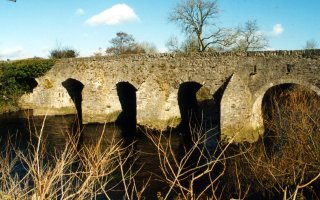 One the way to Naas you have the Caragh Bridge, which is the narrowest
and probably the oldest of all the Liffey bridges. This
is the bridge on our school crest and consists of six stone piers with
round-headed arches.
One the way to Naas you have the Caragh Bridge, which is the narrowest
and probably the oldest of all the Liffey bridges. This
is the bridge on our school crest and consists of six stone piers with
round-headed arches.
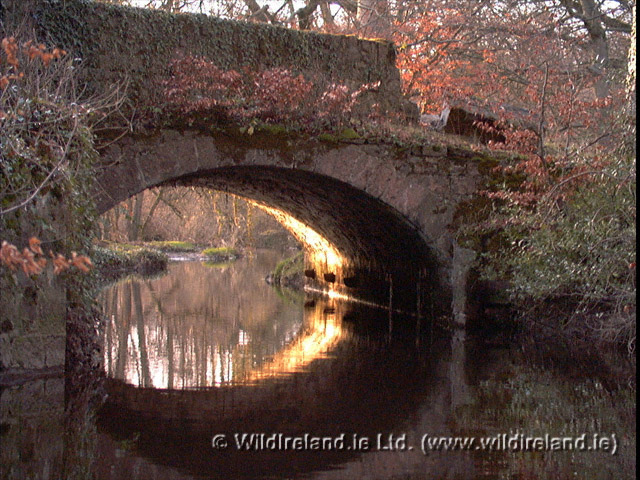 A
little to the south you find Victoria Bridge.
A plaque on this bridge has the said queen’s name hacked off, but the
date of her coronation, 1837, and the builder’s name S. R. Muleada exist.
This bridge sets off one of the most beautiful scenes in all Kildare,
where the mature beech frames the light as it dances with the waters of the
river, slowing and speeding over waterfalls, diverging to a mill pond, with the
majestic four-story mill standing over the lot.
Evidence of a much older crossing exists nearby, possibly to create a
crossing to the mill, which existed many years before any bridge was built.
A
little to the south you find Victoria Bridge.
A plaque on this bridge has the said queen’s name hacked off, but the
date of her coronation, 1837, and the builder’s name S. R. Muleada exist.
This bridge sets off one of the most beautiful scenes in all Kildare,
where the mature beech frames the light as it dances with the waters of the
river, slowing and speeding over waterfalls, diverging to a mill pond, with the
majestic four-story mill standing over the lot.
Evidence of a much older crossing exists nearby, possibly to create a
crossing to the mill, which existed many years before any bridge was built.
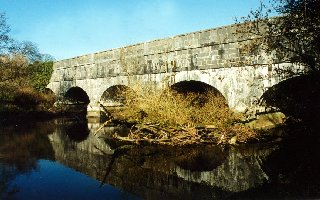 A few
kilometres downstream from the Caragh bridge we find the Liffey flowing under
the Grand Canal and the road. The
bridge, which carries the canal and road over the river, is a most interesting
aqueduct. This aqueduct, known as
the Leinster Aqueduct, was completed in 1780.
A few
kilometres downstream from the Caragh bridge we find the Liffey flowing under
the Grand Canal and the road. The
bridge, which carries the canal and road over the river, is a most interesting
aqueduct. This aqueduct, known as
the Leinster Aqueduct, was completed in 1780.
FINE
HOUSES…
A
number of fine houses are located close to the river in the Caragh area.
This would be expected because of the location of Caragh in relation to
Dublin and in relation to roadways leading out of Dublin.
The
Mansfield family owned three of the houses.
Barrettstown is a 19th Century spired and turreted house,
while its sister, Morristown Lattin, is a Tudor revival building.
Some years ago "The Irish R.M." was filmed there.
Over in
Yeomanstown, an early 18th century double gable-ended house stands
beside the Liffey. This residence
sheltered the Dominicans when they were expelled from Naas.
About a century later they settled in Newbridge, on a site on the banks
of the Liffey. Their fine church,
with its Fr. Flanagan artwork, and its co-educational post-primary school are
thriving in this present site.
As you
pass by Naas on the by-pass you will notice a fine house on your right as you
travel south. This is Osberstown
House, once the home of Dr. John Osmonde, the United Irishman, who was hanged in
Dublin in 1798.
INDUSTRIAL
STRUCTURES…
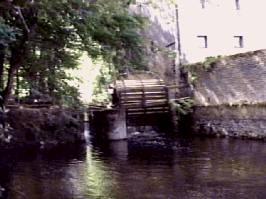 One
of the most outstanding architectural pieces in this area is the Cornmill at
Victoria Bridge. This stands on the
site of an older mill. The history
of the building can be traced back to the time of Cromwell, when it was ruined.
This evidence shows up when Cromwell’s adventurers were laying claim to
the lands of the region. The
building is in the process of being fully restored.
At this point in time most of the parts are back in action, including the
14-foot waterwheel, the huge stones and the gearing.
There are four floors, with fantastic timbers, to the building.
The Cornmill has become known for its artistic and intellectual schools,
the owners of same hoping to provide move access to the public in future.
One
of the most outstanding architectural pieces in this area is the Cornmill at
Victoria Bridge. This stands on the
site of an older mill. The history
of the building can be traced back to the time of Cromwell, when it was ruined.
This evidence shows up when Cromwell’s adventurers were laying claim to
the lands of the region. The
building is in the process of being fully restored.
At this point in time most of the parts are back in action, including the
14-foot waterwheel, the huge stones and the gearing.
There are four floors, with fantastic timbers, to the building.
The Cornmill has become known for its artistic and intellectual schools,
the owners of same hoping to provide move access to the public in future.
![]()